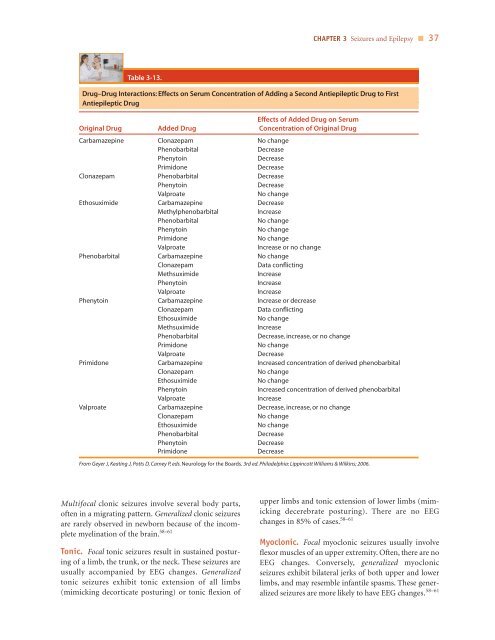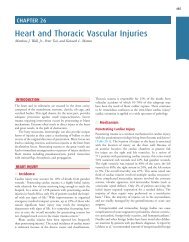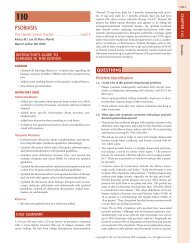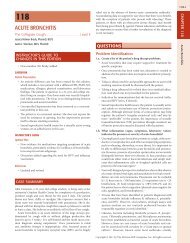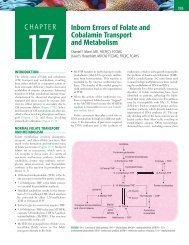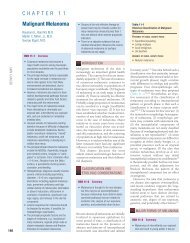Seizures and Epilepsy
Seizures and Epilepsy
Seizures and Epilepsy
You also want an ePaper? Increase the reach of your titles
YUMPU automatically turns print PDFs into web optimized ePapers that Google loves.
Table 3-13.<br />
CHAPTER 3 <strong>Seizures</strong> <strong>and</strong> <strong>Epilepsy</strong> ■ 37<br />
Drug–Drug Interactions: Effects on Serum Concentration of Adding a Second Antiepileptic Drug to First<br />
Antiepileptic Drug<br />
Original Drug Added Drug<br />
Effects of Added Drug on Serum<br />
Concentration of Original Drug<br />
Carbamazepine Clonazepam No change<br />
Phenobarbital Decrease<br />
Phenytoin Decrease<br />
Primidone Decrease<br />
Clonazepam Phenobarbital Decrease<br />
Phenytoin Decrease<br />
Valproate No change<br />
Ethosuximide Carbamazepine Decrease<br />
Methylphenobarbital Increase<br />
Phenobarbital No change<br />
Phenytoin No change<br />
Primidone No change<br />
Valproate Increase or no change<br />
Phenobarbital Carbamazepine No change<br />
Clonazepam Data conflicting<br />
Methsuximide Increase<br />
Phenytoin Increase<br />
Valproate Increase<br />
Phenytoin Carbamazepine Increase or decrease<br />
Clonazepam Data conflicting<br />
Ethosuximide No change<br />
Methsuximide Increase<br />
Phenobarbital Decrease, increase, or no change<br />
Primidone No change<br />
Valproate Decrease<br />
Primidone Carbamazepine Increased concentration of derived phenobarbital<br />
Clonazepam No change<br />
Ethosuximide No change<br />
Phenytoin Increased concentration of derived phenobarbital<br />
Valproate Increase<br />
Valproate Carbamazepine Decrease, increase, or no change<br />
Clonazepam No change<br />
Ethosuximide No change<br />
Phenobarbital Decrease<br />
Phenytoin Decrease<br />
Primidone Decrease<br />
From Geyer J, Keating J, Potts D, Carney P, eds. Neurology for the Boards. 3rd ed. Philadelphia: Lippincott Williams & Wilkins; 2006.<br />
Multifocal clonic seizures involve several body parts,<br />
often in a migrating pattern. Generalized clonic seizures<br />
are rarely observed in newborn because of the incomplete<br />
myelination of the brain. 58–61<br />
Tonic. Focal tonic seizures result in sustained posturing<br />
of a limb, the trunk, or the neck. These seizures are<br />
usually accompanied by EEG changes. Generalized<br />
tonic seizures exhibit tonic extension of all limbs<br />
(mimicking decorticate posturing) or tonic flexion of<br />
upper limbs <strong>and</strong> tonic extension of lower limbs (mimicking<br />
decerebrate posturing). There are no EEG<br />
changes in 85% of cases. 58–61<br />
Myoclonic. Focal myoclonic seizures usually involve<br />
flexor muscles of an upper extremity. Often, there are no<br />
EEG changes. Conversely, generalized myoclonic<br />
seizures exhibit bilateral jerks of both upper <strong>and</strong> lower<br />
limbs, <strong>and</strong> may resemble infantile spasms. These generalized<br />
seizures are more likely to have EEG changes. 58–61


